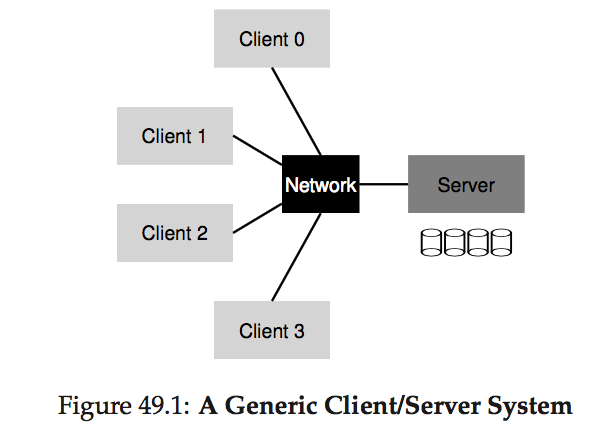"Sun's Network File System (NFS)"
Problem
Design a distributed file system with transparent access to files from clients
System designs

-
the server stores the data on its disks, and clients request data through well-formed protocol messages
-
Architecture advantages:
- easy sharing of data across clients
- centralized administration (backup done on multiple servers instead of many clients)
- security (put server behind firewall)
-
Transparency:
- Location transparency: file name does not include name of the server where the file is stored
- Implemented using NFS Mount Protocol:
- Mount remote directories as local directories
- Maintain a Mount table with (directory, server) mapping

-
Clients talk to server using RPC:
- Use RPC to forward every file system request; remote server executes each request as a local request; server responds back with result (Example: OSTEP Figure 49.5)
- Advantage: server provides a consistent view of the file system to clients
- Disadvantage: performance (use cache)
-
Crash Recovery:
- goal: simple and fast server crash recovery
- Use a stateless Protocol (NFSv2): the server doesn't keep track of anything about what is happening at each client
- Stateful: server maintain a filedescriptor(an integer) to actual file relationship (unknown after recovery)
- Stateless: file handle (a unique identifier for each directory and file).
- Every client RPC call needs to pass a file handle
- Server returns file handle whenever needs (e.g., mkdir)
-
Server failure & Message loss:
- Client retries the request (READ, WRITE are idempotent in NFS)
-
Cache:
- Client side:
- cache file data and metadata by block that is read from server in local memory
- Cache serves as a temporary buffer for writes (allow asyncronous write)
- Advantage: reduce network usage, improve performance
- Disadvantage: write lost in memory after crash (safety vs. performance tradeoff)
- Server side:
- server can buffer the write in memory and write to disk asychronously
- Problem: write in memory can lost
- Sol:
- battery-backed memory
- commit each WRITE to stable storage before ack WRITE success to clients
- Client side:
-
Cache consistency problem:
- Update visibility: when do updates from one client become visible at other clients?
- sol: flush-on-close (write-back cache):
- when a file is written to and subsequently closed by a client application, the client flushes all updates (i.e., dirty pages in the cache) to the server.
- sol: flush-on-close (write-back cache):
- Stale cache: once the server has a new version, how long before clients see the new version instead of an older cached copy?
- sol: issue GETATTR to get file stats (last modified date), if the time-of-modification is more recent than the time that the file was fetched into the client cache, the client invalidates the cache and subsequent reads will go to the server.
- Use attribute cache to reduce GETATTR requests (update attribute cache periodically)
- Still has problem: can still read stale value (polling interval, cache update/invalidation delayed by network)
- Update visibility: when do updates from one client become visible at other clients?
Note
You may think the solution to cache consistency problems look a lot like write-back + invalidation. The geenral idea is the same. However, the solution here takes client's perspective. However, the definitions in my previous post takes server's perspective. More formally, we call client's perspective "client-initiated consistency protocol" and server's perspective "server-initiated consistency protocol".
Remarks
- NFS issues:
- multiple clients update the same file may get inconsistent view of the file (depends on cache update/invalidation, attribute cache polling frequency)
- Clients crash may lose data in buffer (cache)
- NFS Key features:
- Location-transparent naming
- Client-side and server-side caching for performance
- Stateless architecture
- Client-initiated consistency protocol
- Good in NFS:
- Simple
- Highly portable (open protocol)
- Bad in NFS:
- Lack of strong consistency
Reference
comments powered by Disqus